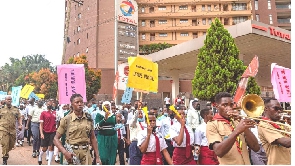 Students in Kampala, Uganda march to the EU mission offices to deliver a petition
Students in Kampala, Uganda march to the EU mission offices to deliver a petition
A new study is laying further criticism on the East African Crude Oil Pipeline (EACOP) for its likely risk on some 158 wetlands along its design route in Uganda alone.
The findings cast a new shadow on the project that has been the subject of debate, as climate activists target it over possible environmental damage.
The Factsheet: EACOP Impacted Wetlands in Uganda, released on July 28, lists five massive wetland systems that the pipeline will cross, putting swamps and their wider ecosystems at risk. These wetlands drain into critical water bodies, including Lake Victoria, Lake Albert and the Victoria Nile.
But oil chiefs behind the Eacop project dismissed the findings as biased and authored by a group that has been consistent in undermining Uganda’s quest to exploit its oil.
The African Institute for Energy Governance (Afiego), which commissioned the study, argues that while horizontal direction drilling is deployed for river crossings, EACOP’s Environmental and Social Impact Assessment (ESIA) downplayed the potential impact that the project would have on the wetlands.
“The project proponents also proposed the open cut construction technique, as opposed to horizontal directional drilling, for crossing the wetlands. The technique has been criticised by experts, noting that “it has the potential of significant impacts, especially in wetlands,” the Afiego report reads.
Eacop requires a 30-metre corridor right of way, which environmentalists say is a big section especially for wetlands, noting that during construction, the digging of trenches, backfilling and other activities could distort the hydrological cycle or water flow of the wetlands.
Key habitats
The key wetlands include Wambabya, Kafu, Nabakazi, Katonga and Kibale-Bukora, each made up of swathes of swamp across 10 districts.
Oil executives in Kampala dismissed the study as another attempt by “poverty conservationists” to stop the project, as the country continues to spend $2 billion on fuel imports annually.
“Those who want to argue, let them keep doing so, but the oil project is going on. And that’s non-negotiable,” said Ali Sekatawa, the director of legal and corporate affairs at the Petroleum Authority of Uganda.
Peter Muliisa, the chief legal and corporate affairs officer at the Uganda National Oil Company (Unoc) said the Eacop ESIA report shows the pipeline routing crosses “minimal swamps” and only “two rivers” in the 10 districts it traverses in Uganda.
“We were forced to change the course a few times where we could avoid the sensitive biodiversity sites," he explained.
To mitigate harm, Muliisa said the project will use horizontal direction drilling, which ensures there is no contact between the pipeline and river waters.
The 1,443km Hoima-Tanga pipeline will be the world’s longest heated pipeline in order to transport Uganda’s crude, which is waxy in nature.
Environmentalists argue that failure of insulation could be catastrophic for biodiversity conservation. Uganda’s wetlands harbour fish and other aquatic life, in addition to hippos, sitatunga, Nile bushbuck, waterbuck, leopard, common oribi, duiker and reedbuck. They also host the Ugandan defassa and some 420 bird species, all critical for tourism.
“If not protected from heat, the wetlands may fail to regenerate,” notes Diana Nabiruma, Afiego’s senior communications officer. She added that although the construction phase of the pipeline is temporary, if by default it opens up the wetlands to encroachers, the damage could be permanent.
According to Muliisa, Uganda cannot abandon its oil. He says the critics of Eacop must aim at improving the country’s good carbon footprint rating for oil production, instead of trying to stop the oil and gas projects.
Uganda’s joint venture partners TotalEnergies and CNOOC, however, say they have designed the oil projects to manage the country’s carbon footprint – by using five solar farms along the pipeline’s route to produce 80 percent of the electricity to power the project, while the other 20 percent comes from the grid.
At 13.3kg of carbon dioxide emission per barrel, they say Uganda’s projects at Tilenga, Kingfisher and Eacop are generally below the global average of 33kg per barrel.
Uganda discovered 6.5 billion barrels of oil in 2006 but disputes with international oil companies delayed the exploitation.
Now these delays have been compounded by the global push to meet the 2015 Paris Agreement’s climate goals to cut greenhouse gas emissions to net-zero by 2050. Those goals include ditching fossil fuels and adopting cleaner energy.
As a result, the development of the sector infrastructure, particularly Eacop which starts in the Uganda’s oil fields in the Lake Albert region and terminates at the Tanzania Indian Ocean port of Tanga has been met with criticism, forcing risk averse global lenders to shun the project’s financing.
Uganda wetlands could provide an average net contribution of about $10,491 per hectare per year, according to the Total economic value of wetlands products and services in Uganda published in the Scientific World Journal Studies in 2023.
This translates into over $22.5 billion for all intact wetlands currently standing at 2,152,600 hectares.
The value of wetlands to local households was about $11.4 billion per year in 2002.
Nearly 80 percent of the communities that live close to the wetlands use them to enhance their livelihoods and for food security needs in addition to providing water for drinking, irrigation, hydropower generation, recreation, fisheries industrial use, transport, waste disposal and agriculture.
“If this happens, we may see reduced water access for some users,” says Diana Nabiruma, Afiego’s Senior Communications Officer, adding that trenching digging could potentially drive-up siltation, while soil dumping could lead to some small wetlands drain into bigger ones, dying up.
“The identity and credibility of the report is important,” he told an oil and gas webinar last week. “The entity that authored this report is a litigant, which has been filing and losing so many cases in the regional courts, in France and everywhere, that we leave our oil in the ground.”